| A | B |
|---|
| The scientific study of the interactions between organisms and the environment is called _____. | ecology p. 1144 |
| Ecology is the scientific study of ______. | the interactions between organisms and the environment p. 1144 |
| The intensity of sunlight that hits the Earth in any given place or season is determined by the ____. | angle that the sunlight strikes the surface of the Earth (Sunlight strikes the Earth most directly at the equator and the angle becomes lower as you move away from the equator. Winter is caused by the fact that due to the Earth's tilt, the angle that the sun strikes the parts of Earth experiencing winter is much lower than when it strikes the same places in summer. A 90 degree angle would be straight overhead. Many people falsely believe that the seasons are caused by the elliptical orbit of Earth around the sun. In the northern hemisphere, the Earth is actually closer to the sun in the winter) p. 1146,  |
| Why do parts of the world around 30 degrees north and south latitude tend to have arid (dry) climates? | Air rises at the equator due to solar heating. As the air rises, it cools and releases a lot of moisture at the equator, but the now drier air starts travelling away from the equator. Around 30 degrees, either north or south of the equator, this dry air sinks back toward land. Sinking air warms as it comes under more and more pressure the closer it gets to the ground. Warm air can hold (the opposite of release) more water, so it rarely rains in these regions. p. 1146,  |
| The windward side of a mountain range is usually ______ than the leeward side which is usually ____ due to the _____ effect | moister, drier, rainshadow effect p. 1148,  |
| During summer and winter, many lakes in temperate regions are ______ with little mixing of warmer layers with the cooler layers. In spring and fall, these lakes experience a phenomenon called ____ in which nutrient-rich water from the bottom rises to the surface and oxygen-rich water from the surface sinks to the bottom and mixing of all layers occurs. | thermally stratified, turnover pp. 1157 and 1158, 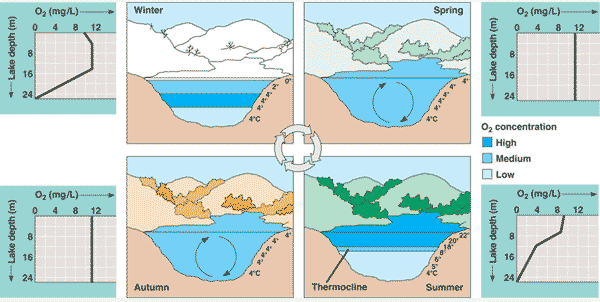 |
| The upper part of an aquatic biome, where enough light penetrates for photosynthesis to occur, is called the ____. | photic zone p. 1157,  |
| The lower layer of an aquatic ecosystem, which doesn't receive enough light to support photosynthesis, is called the _____ . | aphotic zone p. 1157,  |
The bottom substrate of all aquatic ecosystems is called the ____ zone and the organisms that live there are called the ____., 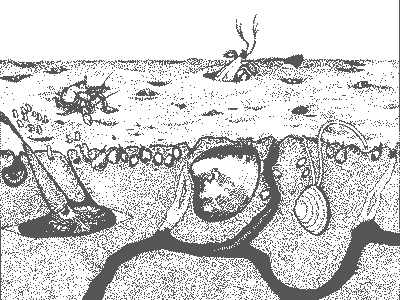 | benthic zone, benthos pp. 1157 and 1162,  |
| The zone of open water that includes both the photic and aphotic zone is called the _____ zone. | pelagic p. 1157,  |
The pond in the picture below is classified as being ______ because of its murky (turbid) nutrient ____ water that supports a lot of life (especially algae).,  | eutrophic, nutrient-rich p. 1159,  |
The lake in the picture below is classified as being ____ because of its clear nutrient ____ waters that support little photosynthetic life., 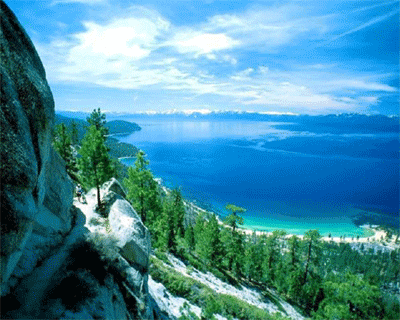 | oligotrophic, nutrient-poor p. 1159,  |
| The part of a lake that is shallow enough to support rooted aquatic plants is called the _____ zone. | littoral zone p. 1159,  |
| The part of a lake that is too deep to support rooted aquatic plants is called the _____ zone. | limnetic p. 1159,  |
The layer of a lake that shows a rapid temperature change, as in the areas between the red lines in the graph and image below, is called a(n) _____.,  | thermocline (the thermocline separates the warm surface waters from the colder, denser, deep waters.) p. 1157, 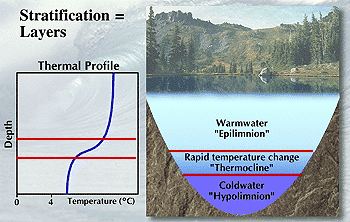 |
| A swamp is a type of wetland dominated by ______. | woody plants p. 1159,  |
| A bog is a type of wetland dominated by ______. | sphagnum mosses p. 1159, 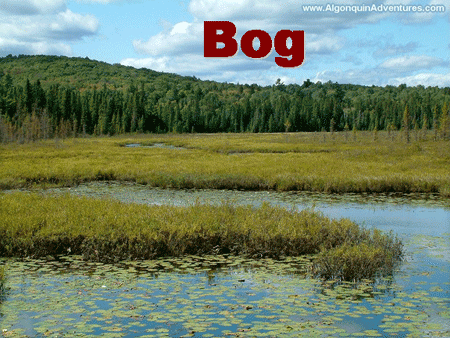 |
A(n) _____ is a type of wetland dominated by sphagnum mosses., 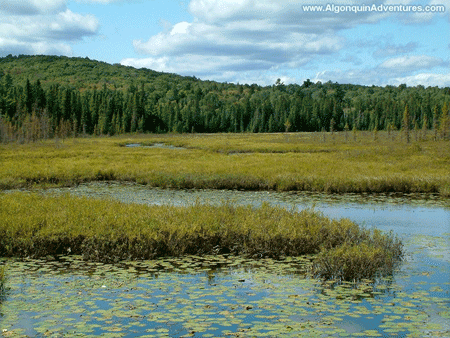 | bog p. 1159,  |
| A(n) ______ is a type of wetland dominated by woody plants. | swamp p. 1159,  |
The type of wetland pictured below is a(n) _____.,  | swamp p. 1159,  |
The type of wetland pictured below is a(n) ___.,  | bog p. 1159,  |
| A(n) ______ is a transition area between river and sea. | estuary p. 1160, 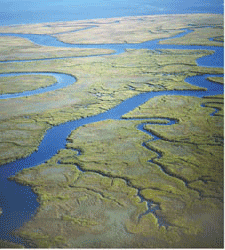 |
| A(n) ______ is found where fresh and saltwater mix. | estuary p. 1160,  |
The picture below shows a tide pool in the _____ zone.,  | intertidal zone p. 1161,  |
The organisms in an intertidal zone, like the ones shown below, must be adapted to be able to survive wide ranges of _____ and _____.,  | water temperature and salinity (saltiness) p. 1161 *This is not something stated directly in this chapter, it is something you should be aware of.,  |
| The largest biome in the world is the ____. | oceanic pelagic biome (the open-ocean covers nearly 70% of the Earth) p. 1161 |
Which biome is shown in the picture below?,  | coral reef p. 1162,  |
| Coral reefs are found in ______ _______ waters. | warm clear p. 1162, 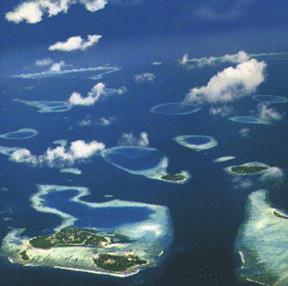 |
| _____ largely determines the distribution and structure of terrestrial biomes. | Climate pp. 1150-1151 |
| ___________ lakes are generally oxygen poor. | Eutrophic (They are oxygen poor because even though they support a lot of photosynthetic algae, that algae dies on a regular basis, sinks to the bottom and is decomposed by bacteria which use a lot of oxygen) p. 1159,  |
The graph below is called a(n) ______.,  | climograph p. 1151,  |
According to the climograph, which factor is most important in determining whether an area will be a broadleaf forest versus a coniferous forest?,  | Average annual temperature (You find the dominant trees changing from broadleaf deciduous to conifers as you go north or up in elevation) p. 1151,  |
According to the climograph, which factor is most important in determining whether an area will be a grassland versus a forest?,  | precipitation (Less precipitation causes a shift to grasslands. Even less precipitation would cause a grassland to turn into a desert) p. 1151,  |
| The area that marks a transition from one type of biome into another is called a(n) _____. | ecotone p. 1152 |
| What are the two main types of tropical forests and what is the main difference between them? | Tropical rain forest and tropical dry forests. The main difference is that in tropical dry forests, you have a dry season and a rainy season. Tropical rain forests are rainy pretty much year around. p. 1153 |
Which biome is pictured below?,  | Tropical forest (The map shows the distribution of tropical forests. The picture is a tropical rainforest in Borneo) p. 1153,  |
Which biome is pictured below?,  | Chaparral p. 1154,  |
Which biome is pictured below?,  | Northern coniferous forest p. 1155,  |
Which biome is pictured below?,  | Desert p. 1153,  |
Which biome is pictured below?,  | Savanna p. 1154,  |
Which biome is pictured below?,  | Temperate broadleaf forest (a.k.a. Temperate Deciduous Forests) p. 1156,  |
Which biome is pictured below?,  | Temperate grasslands p. 1155,  |
Which biome is pictured below?,  | tundra p. 1156,  |
Another name for the northern coniferous forest is the ______.,  | Taiga (This term refers to the part of the biome that borders the tundra but still has conifers, though they are usually a bit on the stunted side due to the cold and wind) p. 1155,  |
| Which terrestrial biome has the greatest biodiversity? | Tropical forests (biodiversity refers to the number of different species that can be found in an area) p. 1153 |
| Which biome is very warm with a dry season that can last eight or nine months? | savanna p. 1154,  |
| Which biome is usually found close to the coast and has mild rainy winters and long dry summers? | chaparral p. 1154,  |
| Which biome is characterized by short drought resistant trees and shrubs? | chaparral p. 1154,  |
| Which biome is characterized by cold dry winters and hot humid summers? | temperate grasslands p. 1155,  |
| Deciduous trees are trees that ______. | drop their leaves in the fall p. 1156,  |
| _________ trees are trees that drop their leaves in the fall. | Deciduous p. 1156,  |
| You can find the tundra biome much further south than normal if you ______. | go up in elevation enough (up taller mountains) p. 1156,  |
| Which biome is characterized by a layer of permafrost just below the surface soils? | Tundra p. 1156,  |
| The tundra is characterized by a permanently frozen layer of soil just below the surface called _____. | permafrost p. 1156,  |
| The uppermost layer of vegetation in a terrestrial biome is called the _____. | canopy p. 1152,  |
| A biome located throughout midlatitude regions where there is sufficient moisture to support the growth of large, broadleaf deciduous trees. | temperate broadleaf forest p. 1156,  |
| Very deep benthic zones (bottom of the ocean areas) are also called the _____ zone. | abyssal zone pp. 1157 and 1162,  |
| Which biome is characterized by sparsely scattered individual trees and large herds of herbivores, large carnivores, and occasional fires and droughts? | savanna p. 1154, 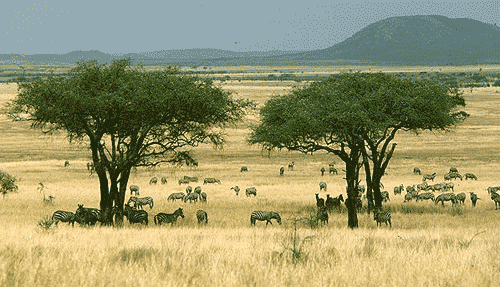 |
| A highly productive lake, having a high rate of biological productivity supported by a high rate of nutrient cycling. | eutrophic lake p. 1159,  |
| A warm-water, tropical ecosystem dominated by the hard skeletal structures secreted primarily by the resident cnidarians. | Coral reef (The cnidarians they are talking about are hard corals like the brain coral pictured below. Notice the white patch of calcium carbonate skeleton that is exposed where the coral polyps have died) p. 1162, 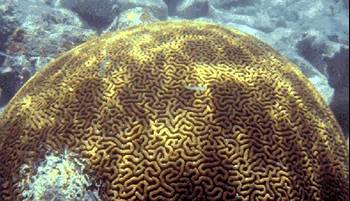 |
| The ______ regions of the world are found between 23.5 degrees north and south latitude. | tropical p. 1146,  |
| The tropical regions of the world are found between _____ degrees north and south latitude. | 23.5 (These latitudes get the sun directly overhead on the longest day of their respective summers) p. 1146,  |
| The shallow region of the ocean overlying the continental shelf. | neritic zone pp. 1157 and 1162,  |
| A dark, hot, oxygen-deficient environment associated with volcanic activity. The food producers are chemoautotrophic prokaryotes. | Deep-sea hydrothermal vents. p. 1162, 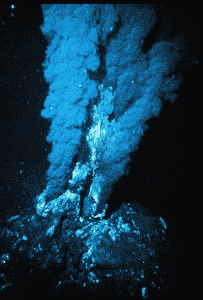 |
| The region of water lying over deep areas beyond the continental shelf. | oceanic zone p. 1157,  |
| A biome at the extreme limits of plant growth. At the northernmost limits, it is called ____, and at high altitudes, it is called ____. | arctic tundra, alpine tundra p. 1156,  |
| A scrubland biome of dense, spiny evergreen shrubs found at midlatitudes along coasts where cold ocean currents circulate offshore; characterized by mild, rainy winters and long hot dry summers. | chaparral p. 1154,  |
| The community of organisms living in the benthic zone of an aquatic biome. | benthos p. 1157,  |
| The mixing of waters as a result of changing water-temperature profiles in a lake. | turnover p. 1158,  |
| In a lake, the well-lit, open surface waters farther from shore. | limnetic zone p. 1157,  |
| The most significant influence on the distribution of organisms is _____. | climate p.1144 |
| ______ is the long-term prevailing weather conditions in a given area. | Climate p. 1144 |
| Research in _____ ecology focuses on the factors controlling exchanges of energy, materials, and organisms across multiple ecosystems. | landscape ecology p. 1145 |
| The _____ is the global ecosystem - the sum of all the planet's ecosystems and landscapes. | biosphere p. 1145 |
| Research in _____ ecology focuses on the regional exchange of energy and materials and how they influence the functioning and distribution of organisms across the biosphere. | global ecology p. 1145 |
| Which branch of ecology would be most likely to investigate the following question? "How does ocean circulation affect the global distribution of crustaceans?" | Global ecology p. 1145 |
| Which branch of ecology would be most likely to investigate the following question? "To what extent do the trees lining a river serve as corridors of dispersal for animals?" | Landscape ecology p. 1145 |
| A(n) ______ is the community of organisms in an area and the physical factors with which those organisms interact. | ecosystem p. 1145 |
| An ecosystem is the community of organisms in an area and the _________ with which those organisms interact. | physical factors p. 1145 |
| An ecosystem is the __________ of organisms in an area and the physical factors with which those organisms interact. | community p. 1145 |
| Research in _____ ecology focuses on energy flow and chemical cycling between organisms and the environment. | ecosystem ecology p. 1145 |
| Which branch of ecology would be most likely to investigate the following question? "What factors control photosynthetic productivity in a temperate grassland ecosystem?" | ecosystem ecology p. 1145 |
| A(n) ____ is a group of populations of different species in an area. | community p. 1145 |
| Research in _____ ecology focuses on how interactions between species, such as predation and competition, affect community structure and organization. | community ecology p. 1145 |
| Which branch of ecology would be most likely to investigate the following question? "What factors influence the diversity of species that make up a forest?" | Community ecology p. 1145 |
| A(n) ____ is a group of individuals of the same species living in an area. | population p. 1145 |
| Research in _____ ecology focuses on factors that affect population size and how and why it changes through time. | population ecology p. 1145 |
| Which branch of ecology would be most likely to investigate the following question? "What environmental factors affect the reproductive rates of locusts?" | Population ecology p. 1145 |
| Which branch of ecology would be most likely to investigate the following question? "How do hammerhead sharks select a mate?" | Organismal ecology p. 1145 |
| Research in _____ ecology focuses on how an organism's structure, physiology, and behavior meet the challenges posed by its environment. | organismal ecology p. 1145 |
| What are the four most important abiotic factors in determining climate? | temperature, precipitation, sunlight, and wind p. 1147 |
| Patterns of climate on the global, regional, or landscape levels are referred to as ______. | macroclimate p. 1147 |
| Patterns of climate on a very fine scale, that differ from the surrounding climate, such as specific climate conditions underneath a fallen log, or those next to a waterfall, are referred to as ________. | microclimate p. 1147 |
| The living factors in an environment are called ____ factors. | biotic p. 1149 |
| The non-living factors in an environment are called ____ factors. | abiotic p. 1149 |
| The burning of fossil fuels along with deforestation are increasing the concentration of ____ and other ______ gases in the atmosphere and are causing the average global temperature to increase. | carbon dioxide, greenhouse gases p. 1149 |
| Many of the world's deserts are found around _____ degrees north and south of the equator, where dry descending air masses occur. | 30 p. 1146,  |
| What type of biome is usually found 30 degrees north or south of the equator? | deserts (This is due to the fact that air circulating in the atmosphere tends to descend at these latitudes. The air has already released most of its moisture near the equator. Air warms as it descends, making it even less likely that condensation will occur) p. 1146,  |
| _______ are major life zones characterized by vegetation type (in terrestrial ones) or physical environments (in aquatic ones). | Biomes p. 1150 |
| Terrestrial biomes are characterized by the predominant type of ______ found there. | vegetation p. 1150 |
| ______ biomes are aquatic biomes with salt concentrations somewhere around 3% while _____ biomes have salt concentrations near or below 0.1%. | Marine, freshwater p. 1157 |
| Oceans cover about ____ of the planet's surface. | 75% p. 1157 |
| Dead organic matter is called _____. It is a major source of food for many benthic organisms that depend on it to rain down from creatures that lived (and have now died) up in the photic zone. | detritus p. 1157 |
| The headwaters of a river are found furthest ______. | upstream (include the smaller fast flowing streams up in the mountains that join into larger and larger streams and rivers flowing toward the mouth of the watershed near the ocean) p. 1160 |
| The mouth of a river is located farthest ____. | downstream (where the river meets the ocean) p. 1160 |
| Any organism that is not strong enough to swim against the current (and therefore basically floats and drifts) is referred to as ______. If they are photosynthetic, they are called _____. If they are heterotrophs, they are referred to as ____. | plankton, phytoplankton, zooplankton (1159-1161),  |
| The largest terrestrial biome on Earth is the ____. | Northern Coniferous Forest p. 1155,  |
| The movement of individuals away from their area of origin is known as ______. | dispersal p. 1164 |
| The root word "a-" means ___. | without (example - "asexual" means "without sex") |
| The root word "geo-" means ___. | The Earth (example - Geology is the study of the Earth) |
| The root word "inter-" means ___. | between (example - the intertidal zone is the zone of beach that lies between high tide and low tide) |
| The root word "limn-" means ___. | lake (example - Limnology is the study of lakes. The limnetic zone the well-lit, open surface waters of a lake farther from shore) |
| The root word "eu-" means ___. | good, well (example - Eutrophic refers to an aquatic system with good amounts of nutrients or food. "Troph" refers to food) |
| The root word "oligo-" means ___. | small, scant (example - An oligotrophic lake has little nutrients and food. "Troph" refers to food.) |
| The root word "micro-" means ___. | small (example: A microclimate is a climate that happens in a small area) |
| The root word "thermo-" means ___. | heat (example - a thermocline is a depth of a lake where the temperature changes rapidly. The root word "-cline" means slope. The graph of a thermocline shows a steep slope in temperature change in the depth where the thermocline occurs) |